Under 5,000 enrollment
High School Inclusion Works
Upper St. Clair School District, Upper St. Clair, Pennsylvania
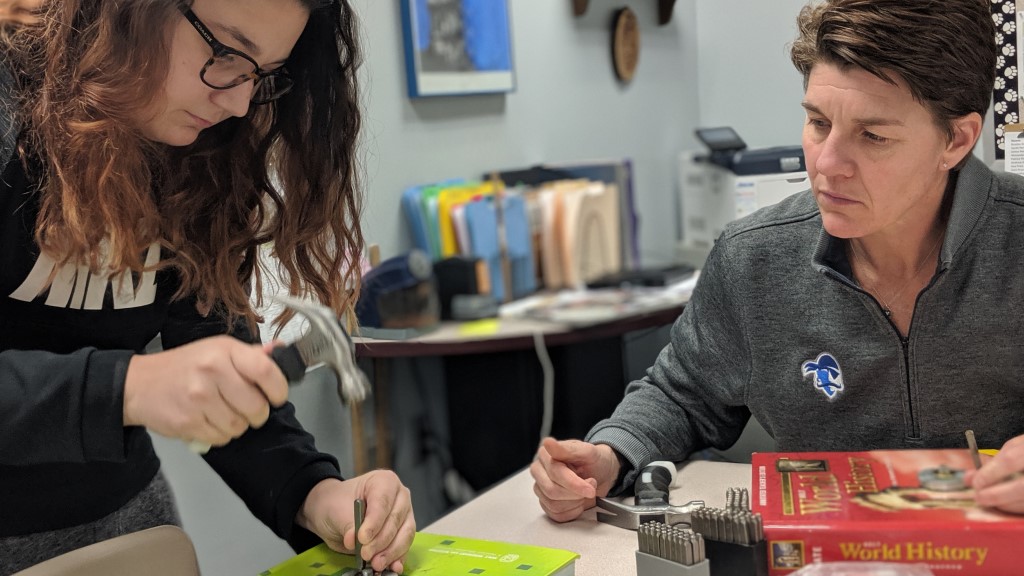
Students in the program receive support to be successful in high school. Photo courtesy of Upper St. Clair School District.
The 409 Program
The goal of the 409 Program has been to provide high school students with significant mental health needs the opportunity to fully participate in their public school. The program provides comprehensive learning supports, intensive therapeutic/emotional supports, behavior management, social skills training, individualized coursework, and community-based service-learning opportunities. The 409 is the classroom number; the program is an innovative support program within a highly successful suburban high school.
The 409 Program was created 15 years ago in response to parental concern regarding children’s ability to attend high school if they exhibited emotional and behavioral issues that impacted their learning. Students with significant mental health issues had to attend specialized schools outside the district. Going outside the district left students feeling ostracized and negatively impacted their lives within the community.
Participating students qualify for special education services and exhibit a variety of mental health diagnoses, including autism, anxiety, depression, post-traumatic stress disorder, bipolar disorder, and/or oppositional defiant disorder.
Within the 409 classroom, the staff creates a therapeutic milieu, a classroom environment that feels safe, where students can share their struggles and seek help from the classroom staff or their peers. The classroom has become a sanctuary for students. Within their supportive community, students can begin to develop resiliency and experience more success in high school.
Removing barriers: The 409 Program seeks to remove the barriers to achievement in five key ways: (1) uncovering the gifts of each student despite their challenges and providing opportunities to grow, (2) collaborating with parents and outside providers, (3) addressing the therapeutic needs of students, (4) providing the necessary academic supports and accommodations, and (5) enhancing social skills development through community-based service learning.
Students receive individual and group therapeutic sessions to address their diagnoses and presenting problems. When students experience behavioral challenges within their general education classes, the emotional support teacher and licensed social worker collaborate with teachers to create solutions.
Academic and learning needs also are addressed. Students are scheduled into any high school course that meets their needs. Some students participate in honors and Advanced Placement classes, while others enroll in academic classes or vocational-technical experiences. Academic supports are delivered based on each student’s needs. Students have access to the 409 classroom throughout the day and can receive academic instruction as needed to support their involvement in general education classes.
Evidence of success: Students have experienced a higher level of academic success as measured by course grades and participation in higher-level classes. Some students struggled academically before their involvement in the 409 Program but then were able to benefit from the program supports and earn higher grades. In addition to better academic success, 409 students also demonstrated improved behavior as measured by progress on their individual behavior goals.
Over the past 15 years, 85 students have graduated from Upper St. Clair High School after participating in the 409 Program. These graduates have experienced positive postsecondary outcomes. Forty-one students have completed postsecondary education.
Contact
Amy Pfender
Assistant to the superintendent
apfender@uscsd.k12.pa.us
www.uscsd.k12.pa.us
Preparing Students for Tech Sector Jobs
CodeRVA Regional High School, Richmond, Virginia
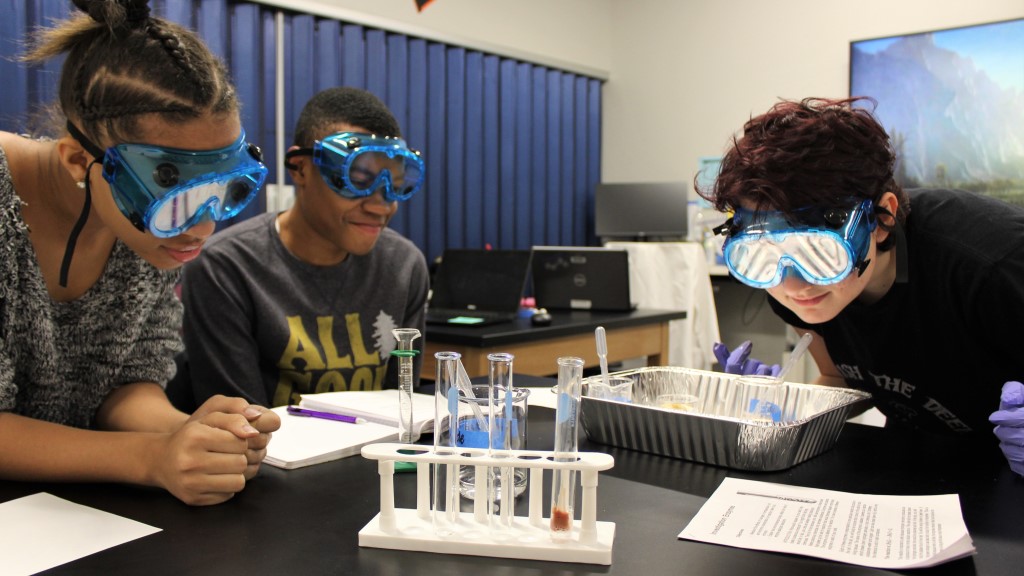
CodeRVA’s innovative curriculum integrates multiple academic content studies and incorporates authentic project-based learning. Photo courtesy of CodeRVA Regional High School.
CodeRVA Regional High School
CodeRVA Regional High School is a next-generation high school focused on preparing a diverse pipeline of students for careers in the tech sector. The school’s design builds on models across the nation that rethink the use of time and space, leverage technology to accelerate learning, personalize learning experiences, and redesign curriculum to align with competency-based progressions. Focused on computer science, the school offers the opportunity to complete high school requirements through a combination of blended (online and face-to-face) learning, integrated coursework, and project-based learning. Students are provided an opportunity to graduate with a Virginia high school diploma, an associate degree in computer science from J. Sargeant Reynolds Community College, industry certifications, and paid internships in computer science-related fields. CodeRVA’s approach to learning develops students’ self-management skills while integrating academic content, agile workplace methodologies, and internship experiences that provide a pipeline of critical thinkers prepared to enter college or Richmond’s growing tech sector.
In support of its mission to focus on computer science and provide opportunities for all students, CodeRVA enrolls every ninth-grade student in Advanced Placement (AP) Computer Science Principles class. The course introduces students to the creative aspects of programming, abstractions, algorithms, large data sets, the internet, cybersecurity, and how computing impacts our world. Students develop the computational thinking skills needed to fully use the power of digital technology and help build a strong foundation in core programming and problem solving. The course prepares students for the associated AP exam.
Removing barriers: The three main goals at CodeRVA are: redesign the high school experience to better meet the learning needs of today’s students; address racial, economic, and gender inequities in STEM-related education; and increase the pool of potential employees in computer science-related fields for central Virginia employers.
CodeRVA serves a population of students that ranges from 31 percent to 51 percent of students eligible for free and reduced-price meals. The school provides several opportunities and services for students that support their success. They also provide college and career services to students and guidance to students and their families.
There are no admissions criteria or academic prerequisites to attend CodeRVA. Students are selected through an independently operated lottery system that ensures diversity reflective of the Richmond region.
Evidence of success: Currently, there is an ongoing independent evaluation implemented by Virginia Commonwealth University. In addition, the school, in three years, has achieved increasing support through 14 school divisions, three universities, the Virginia Department of Education, the YMCA, and numerous businesses—including Capital One, CarMax, and Snagajob, among others. Due to student growth, the school footprint has grown from 15,310 square feet to over 43,000 square feet in three years.
Contact
Gail Hardinge
School board member
ghardinge@nkcps.k12.va.us
http://coderva.org
Transition for Special-Needs Students
Bergenfield Public Schools, Bergenfield, New Jersey
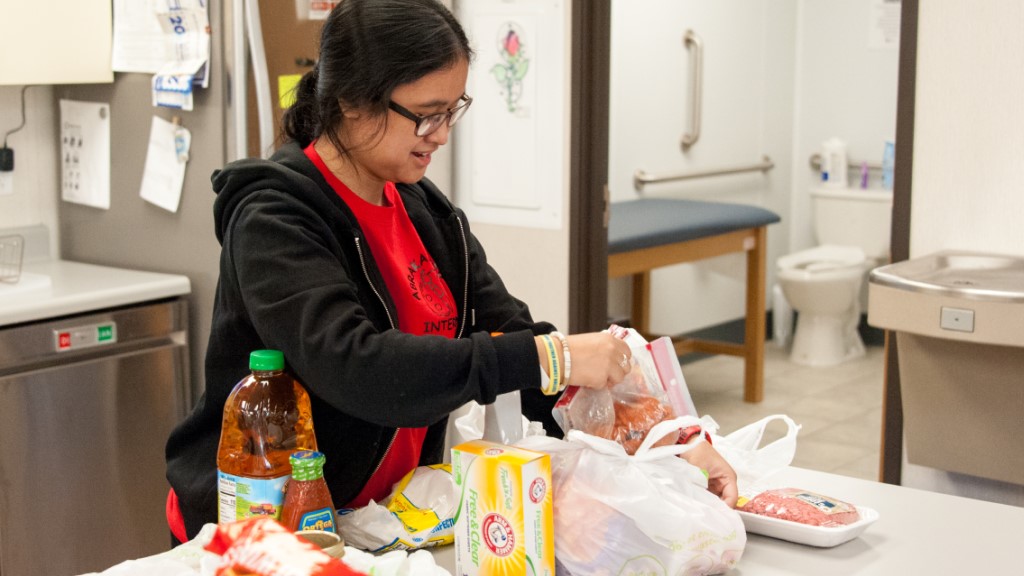
A student unbags groceries after returning from the supermarket. Photo courtesy of Bergenfield Public Schools.
IEP For Life Project
Bergenfield Public Schools has seen great success in delivering access to the best teachers and a rigorous curriculum. However, an assessment in 2017 revealed that students with severe disabilities—ages 16 to 21—were not prepared for anything at all after high school.
The district recognized that it was not providing the staffing, curriculum, systemic vocational training, employment opportunities, formalized partnerships, and classroom resources needed to adequately prepare targeted students for postsecondary success and independent living.
It created the IEP for Life Project to target a cadre of 20 students in grades nine through 12. The group included students with classifications including intellectual disability and autism.
The district began by increasing staff to improve the staff-to-student ratio; training staff to implement person-centered planning and instruction, purchasing new curriculum and instructional supplies, and building a manufactured home called the Bear Den to enable students to practice life skills. It also increased access to community-based instruction, and structured learning experiences; to internships, employment, and community service opportunities; and to postsecondary adult education and college classes.
Removing barriers: The district dramatically increased access to postsecondary instruction and career training for high school students with severe disabilities. It increased staff from three teachers to seven staff members, including three special education teachers and four paraprofessionals. The district also increased the hours of the transition coordinator to full time; this made a significant difference in offering improved structured learning experiences and community-based instruction experiences. Students and parents participated in Person Centered Approaches in Schools and Transition training, and a vocational profile was developed for every student.
Evidence of success: The district has successfully developed a transition program that exists in an independent structure. The program includes community-based instruction and structured learning experiences matched to students’ interests and skills. Other goals of the project are the development of independent living skills and increased opportunities for leisure and physical activities in the community. In terms of student performance, 100 percent of students have demonstrated improvement in social skills as a result of the project.
Through the IEP for Life Project, the district has improved its student-to-staff ratio to provide the extra time and extra help students need to succeed and increased stakeholder planning among families, staff, and community partners from once a year to once a month.
Staff professional development hours rose from four hours to 40 hours per year. The number of parents contributing to a vocational plan for students with severe learning disabilities increased. Parents also participated in events planned by their children, including Back to School Night, Holiday Dinner, and April Brunch. A notable event was the Completion Ceremony, as many parents felt that a “graduation” might not have been in their future.
The number of recreational hours that students with disabilities spent with nondisabled peers increased from 1.5 hours per week to five hours per week. Students increased their fitness activities and learned to track steps and their heart rate on Fitbits. They also learned to download data from their Fitbit to their laptops to assess their progress.
Contact
Christopher Tully
Superintendent
ctully@bergenfield.org
www.bergenfield.org
Support for English Learners
Manassas Park City Schools, Manassas Park, Virginia
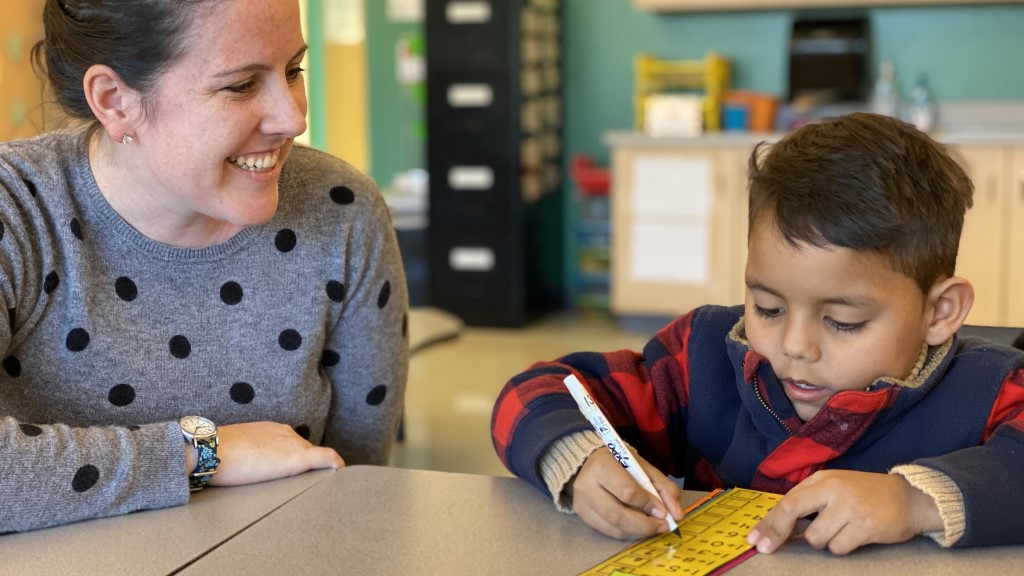
Students learning English receive personalized language plans. Photo courtesy of Manassas Park City Schools.
Language Acquisition Program
A 2.5 square-mile city in northern Virginia is home to a richly diverse school division of 3,600 students who come from 50 different countries and speak 47 different languages. Nearly 60 percent of incoming students are identified as English Learners and considered economically disadvantaged. Recognizing the diverse needs in the division and knowing that English language proficiency would be crucial for student academic success, Manassas Park City Schools developed a literacy package that incorporated language art skills in each instructional lesson while allowing students to move through self-paced independent work.
Already on the cutting edge of a digital 1-to-1 rollout, the district aimed to harness technological tools to boost English learning. The Language Acquisition Program was created to enable a diverse set of teaching strategies that provide each student with a personalized language acquisition plan. Emphasizing language acquisition, the program fosters speaking, listening, reading, and writing in English throughout all instructional units. It uses technology-based platforms to reinforce learning.
Removing barriers: The Language Acquisition Program helps to level the academic playing field and paints a picture of what each student can become. The ability to independently assess and support each student’s learning ensures students remain engaged and have the best possible opportunity to master material that is commensurate with his or her ability.
The division’s 1-to-1 digital rollout extends to all K-12 students, and that five-year program laid a foundation of support services throughout the community that includes internet access to underserved families. To further capitalize on the work done to maximize the effectiveness of the division’s digital plan, the decision to use technology to support language acquisition made both academic and fiscal sense.
Before any intervention and skill development program is introduced into a learning environment, interventionists, literacy and math specialists, instructional technology resource officers, and teachers work together for program evaluation. Once approved, programs are used in small groups before full implementation. Specialists work directly with teachers for needed training and implementation schedules.
Teams have a flat organization so that decisions can be made, and the implementation of good tools can occur quickly. Rather than bring a great tool to all students, the Language Acquisition team’s goal is to bring the right tool to each student.
The district uses progress monitoring software to ensure student growth. If student goals are not being met, recurrent progress monitoring allows educators to quickly identify and transition to different educational tools, further closing equity gaps in the classroom.
Evidence of success: Since its full implementation three years ago, the program has had a big impact on English language acquisition. Currently, district students are exceeding 2020 state-established progress targets and outpacing the state average for achieving English language proficiency. Manassas Park Elementary School has already surpassed the state 2021-22 testing year target for English Learner progress by 10 percentage points.
Contact
Marta Craighill
marta.craighill@mpark.net
www.mpark.net
Remote Medical Care for Students and Staff
Shawnee Public Schools, Shawnee, Oklahoma
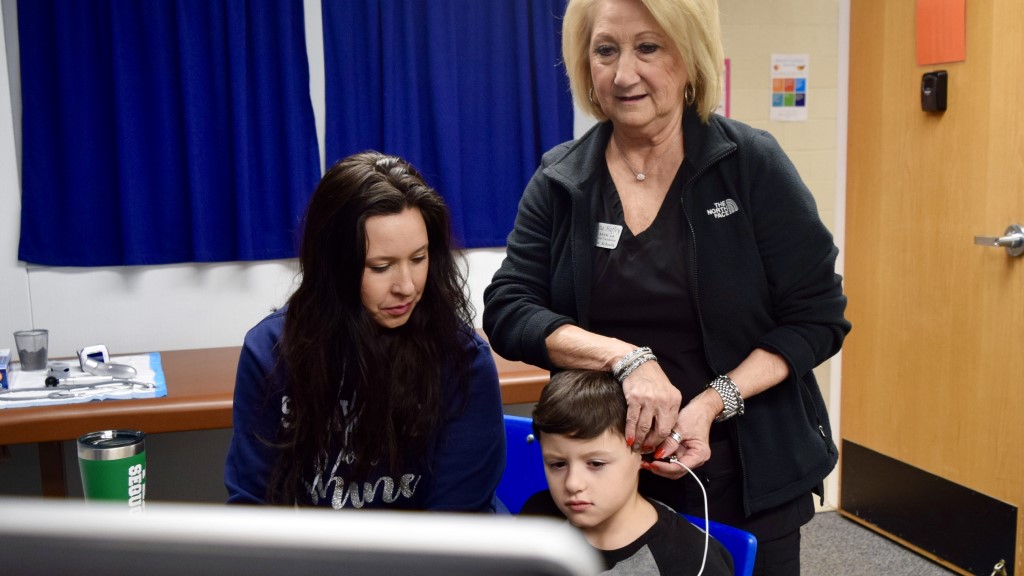
Telemedicine helps provide nonemergency medical care. Photo courtesy of Shawnee Public Schools.
Telemedicine Partnership
Shawnee Public Schools students were unable to access proper medical care. The district has a student population in which more than 95 percent qualify for free and reduced-price meals, and almost 6 percent are identified as homeless. This level of poverty made accessing adequate health care difficult for many families. Students missed school for easily treatable conditions, such as ear infections. Other students remained at school when they needed medical care because parents had no reliable transportation or no way to leave work in the middle of the day to care for the child.
The district formed a partnership with TEAM Clinics to provide prompt, nonemergency medical care to students. TEAM Clinics uses a telemedicine video platform that allows the student, school nurse, parent, and health care provider to meet virtually. With a parent’s permission, the school nurse contacts a provider. Through specialized equipment and the nurse’s guidance, the provider can examine and assess the student. The parent may use a free mobile app to attend the health examination virtually. The provider can then prescribe medicine, if necessary, and call the prescription into the pharmacy for the parent to pick up. TEAM Clinics bills the family’s insurance or, if the student does not have insurance, covers the cost of care pro bono. TEAM Clinics is a privately held and growing company. There is no cost to the district for the telemedicine partnership. The company also provides the technology platform to work from and the necessary on-site equipment to facilitate each visit, such as stethoscopes, otoscopes, oxygen meters, and blood pressure cuffs.
The district employed school nurses and health aides to serve all school sites prior to the addition of the TEAM Clinics program, so the district has not seen any additional staffing costs.
Removing barriers: This program has given students access to needed medical care. Most of the time, students can return to class at the conclusion of the telemedicine visit, thus lessening the number of absences for at-risk students. The district also found that staff members were using the telemedicine clinics if they felt ill during the day. Teachers could stay at school because they were not contagious, and students were taught by their certified instructor rather than a substitute. Any time a student or staff member was found to be contagious, the school nurse could send the patient home. Preventing the spread of illness has kept at-risk students from missing school days. Thirty percent of Shawnee’s student population are citizens of a Native American tribal nation.
Evidence of success: A total of 158 patients visited the TEAM Clinics in 2018-19, the program’s first year of operation. Of that number of patients, only 10 (five students and five teachers) were sent home due to illness. The program began in the fall of 2018 in four school sites in the district. Now, the clinics serve students and staff in each of the district’s eight school sites. In this second year of the program, TEAM Clinics is expanding its health care offerings to include behavioral health services and treatment for students and staff.
Contact
Cherity Pennington
Communications/library services coordinator
cpennington@shawnee.k12.ok.us
www.shawnee.k12.ok.us
5,000 to 20,000 enrollment
Building Relationships Between Parents and Schools
Cajon Valley Union School District, El Cajon, California
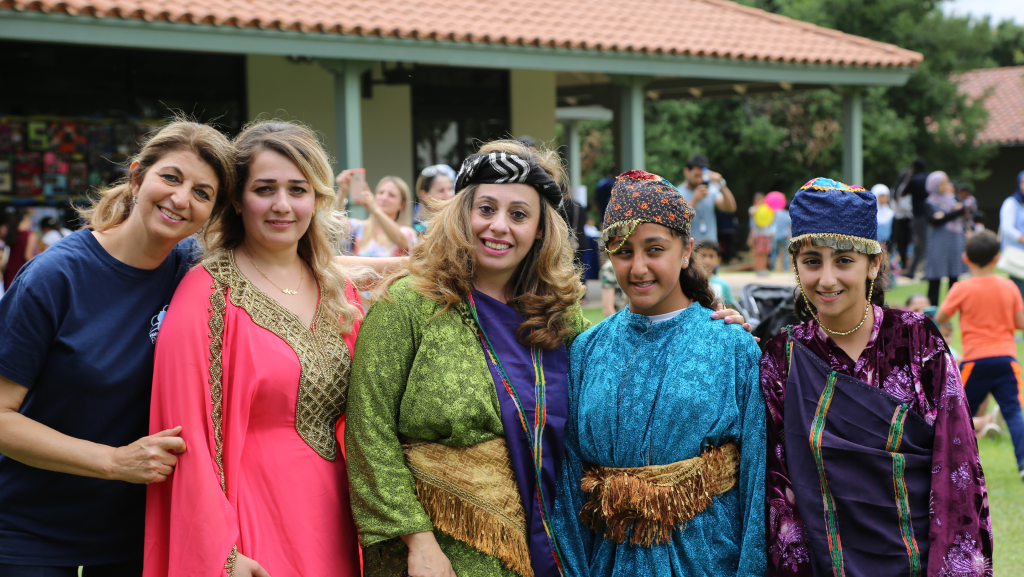
FACE helps build community among teachers, parents, and schools. Photo courtesy of Cajon Valley Union School District.
Family and Community Engagement Department (FACE)
The Cajon Valley Union School Board initiated the Family and Community Engagement department (FACE) as the disparity in community and parent engagement became more and more evident within schools. The lower-socioeconomic schools received little to no support for their parents and community, while higher socioeconomic schools received a wide range of supports. After the FACE office was created, the district saw an influx of refugees from Iraq, Afghanistan, and Syria. This shifted district needs, and the FACE office became a vital member of the community and district to support the newcomers. It evolved and grew into a robust program based on positive feedback from teachers, parents, and students.
Removing barriers: Barriers are removed through relationships, and the program builds connections intentionally. Community liaisons build relationships with parents and help school staff and parents build relationships. The district does not want the liaison to be the only one who has a relationship with parents; instead, they help build a relationship between the staff members and parents. This is accomplished in several ways.
Family-teacher teams allow teachers to repurpose back-to-school night. Teachers give parents time to share their specific hopes and dreams for their children in a large group. This builds community among the parents and, of course, with the teacher. Most students have a parent or caregiver at home, but many caregivers do not know how to support their children academically.
Positive home visits are a powerful way for school staff to build meaningful relationships with parents that can forever change the parent and the teacher. The teacher asks to visit the home well in advance, and the parent agrees or disagrees. Next, the teacher and community liaison visit the home and ask one question: What are your hopes and dreams for your child? They spend the rest of the time listening.
Parent University is a program where a teacher and a community liaison work together to teach a group of parents specific reading strategies and parenting skills. The teachers model these strategies with the parents. When parents graduate, they become roving readers in the classrooms. The students see that their parents value education.
Evidence of success: The program has been running and growing for the past four years. Last year, the California State Assembly passed a $13 million bill to create a Family and Community Engagement model. The goal is to spread this work to districts across the state of California. Cajon Valley applied and was accepted after a full-day interview to be one of six districts to work on this initiative for the next three to five years.
FACE’s implementation model was to start small with interested and willing participants, and then to use those initial participants to help recruit other school sites. It now has 14 itinerant community liaisons that support all sites on some level, but traditionally Title I sites receive more time based on student needs.
Contact
Michael Serban
Director of family and community engagement
serbanm@cajonvalley.net
www.cajonvalley.net
Ready for College, Career, and Life
Meriden Public Schools, Meriden, Connecticut
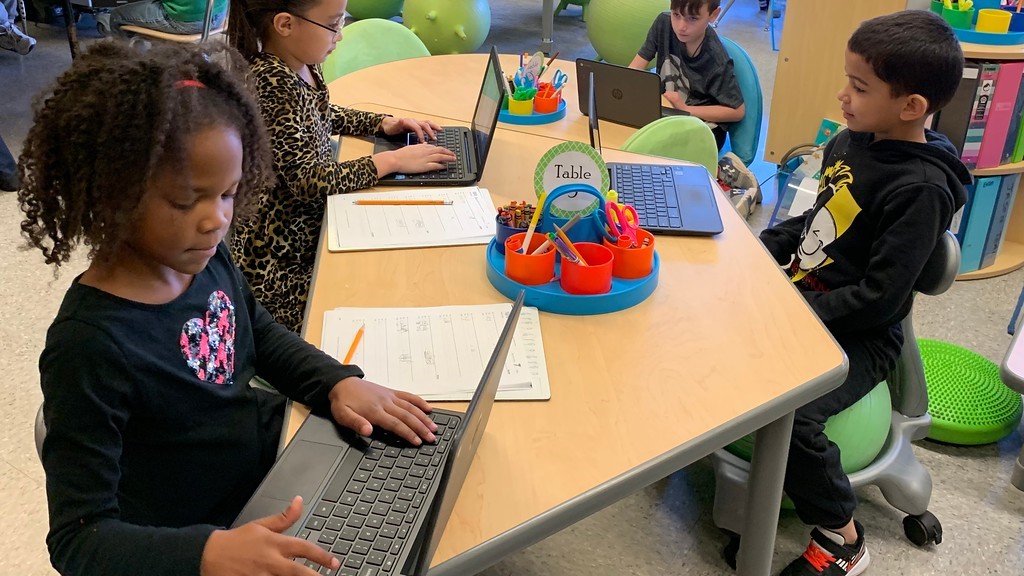
Students use mobile devices to access digital content. Photo courtesy of Meriden Public Schools.
Equity and Access: Success for All
Too many students were leaving Meriden high schools with uncertain postsecondary plans. The Equity and Access: Success for All initiative is designed to ensure all students leave high school ready for college, career, and life.
The initiative includes personalized pathways, which have led to greater choice and voice, critical thinking, creativity, and academic gains. A suite of tools helps staff get to know students and measure their college and career readiness.
“No-Zero” grading procedures support student effort, leading to greater engagement and motivation. Restorative practices and youth dialogue groups have increased student voice and improved school climate. Students are provided district-issued mobile devices to use with digital content in classes and on their own to explore anytime, anywhere learning. Commitment to student ownership is enhanced by providing high school students with opportunities to design their own credit-bearing personalized learning experiences based on interest, talent, or potential career options.
Removing barriers: Success for All builds a college and career culture for all students, starting with all incoming kindergarteners receiving T-shirts with the year they will be graduating college.
With open access to classes, including Advanced Placement (AP) classes, there are no barriers to accessing high-level learning. Since implementing open access to AP courses, enrollment of students of color has increased exponentially. The school board funds AP testing and voted to require all 11th-grade students to participate in an SAT preparation course. Middle school students can earn high school credits, while high school students are able to earn college credits.
A summer bridge program held at the two high schools supports at-risk entering ninth-graders. The board’s curriculum committee created a High School 101 course to prepare students socially for high school. Follow-up during ninth grade is provided by on-track grade nine transition counselors. To increase credit accumulation and reduce failures, transition counselors provide intensive “case management” to a targeted group of underserved ninth-graders.
Evidence of success: Success for All has been highly effective in increasing achievement, attendance, behavior, and graduation rates over the last decade. During this period, while both numbers of students eligible for free and reduced-price meals and students of color increased significantly, academic performance measures reveal the highest scores in district history. Other attendance and behavioral indicators also show growth. On the Connecticut Accountability Index, the Connecticut State Department of Education’s report card for districts, Meriden’s achievement growth from 2015 to 2019 outpaced the state and the 33 urban districts identified as the most economically challenged districts in Connecticut.
Meriden has 96 percent of ninth-graders on track to graduate in four years, up from 75 percent several years ago. Most importantly, over the last five years, four-year graduation rates have increased by 20 percent. Behavioral indicators also show highly positive results: chronic absenteeism decreased by 23 percent, suspensions by 82 percent, and expulsions by 93 percent.
Contact
Barbara Haeffner
Director of teaching and innovation
barbara.haeffner@meridenk12.org
http://meridenk12.org
Curriculum and Student Voice
Roseville Area Schools, Roseville, Minnesota
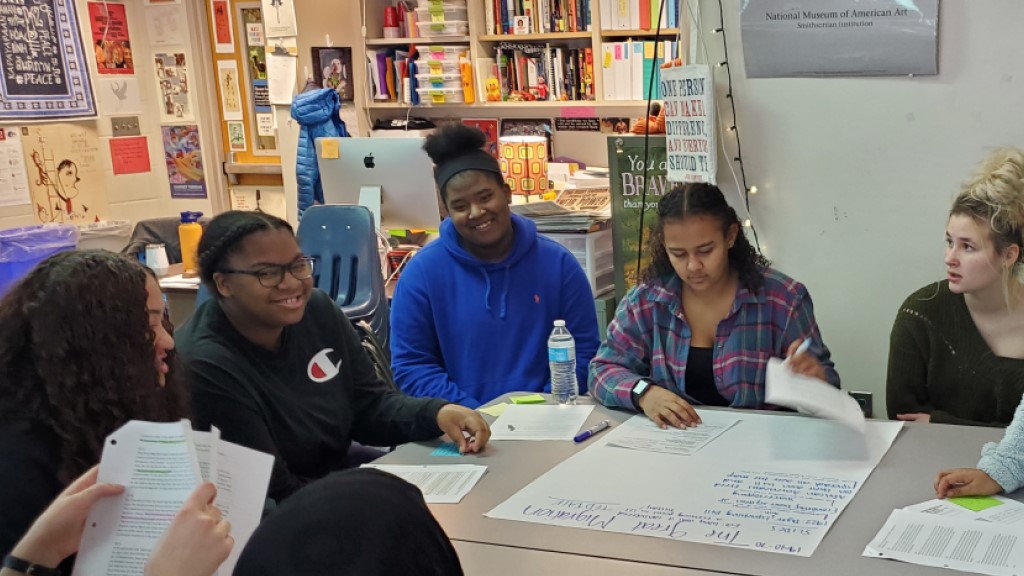
Students asked for and received curriculum changes for equity. Photo courtesy of Roseville Area Schools.
Engaging All Students Through Relevant Curriculum
Roseville Area Schools has been working for over a decade to close the significant gaps in opportunities and outcomes for its diverse student population. After several years of enhancing Culturally Responsive Teaching skills, on Nov. 18, 2016, it had a wakeup call that galvanized students and the community. A few months before, a black man (Philando Castile) was shot by police in a routine traffic stop in the district. This deeply disturbed everyone, and a large group of high school students decided to act. They staged a walkout and presented their demands at the Minnesota Department of Education located nearby. Half of their demands related directly to curriculum. District administrators met with the students and committed to working on the missing narratives.
Within six months, the district began using an Equity Curriculum and Instruction Compass co-created with consultant Marceline Dubose. The initial focus has been on curriculum, with the Engaging All Students Through Relevant Curriculum Program. Its objective is to de-center dominant narratives and expand learning to include traditionally absent narratives and to make the learning materials reflective and relevant to the diversity of perspectives, histories, and identities in the student body and society.
The work is proceeding in all grades, from kindergarten to high school seniors. K-6 has mainly focused on revising all social studies units. For example, in second grade, the unit studying good citizenship now includes a culturally and racially rich array of figures. In fourth grade, students look at the U.S. government and then compare it to tribal government. The work in the middle and high school has been applied broadly across subject matter. Some examples include shifting from only the dominant narrative to a multi-ethnic perspective in covering American history (retitled American Histories); adding American history through an African American lens course as an option to meet the U.S. history requirement; creating a more diverse literature experience in language arts classes with greater representation of different races, cultures, gender, etc.; using skin color to study genes and evolution in biology; and shifting in math classes from academic examples to real-life scenarios.
Removing barriers: This program gives students a context within which they can develop into engaged, motivated, and self-regulated learners. The key impetus came from students, with underserved students’ voices strongly represented. They believed curriculum was key to what needed to change. It needed to reflect their racial and ethnic communities, histories, and leaders, and build connections to their lived experiences.
Evidence of success: Through helping to improve attention and engagement, this program has contributed to the growth in students graduating from high school and a narrowing of race-ethnicity gaps. From 2014 to 2018, the four-year graduation rate increased by 1 percent, ending with 88 percent of students graduating in four years. Because the gains were concentrated among students of color, the graduation gap between white students and students of color narrowed 112 percent. The district and nearly all race-ethnic groups currently outperform the state of Minnesota.
Contact
Kitty Gogins
School board chair
kitty.gogins@isd623.org
https://www.isd623.org/
Finding Common Ground
San Luis Coastal Unified School District, San Luis Obispo, California
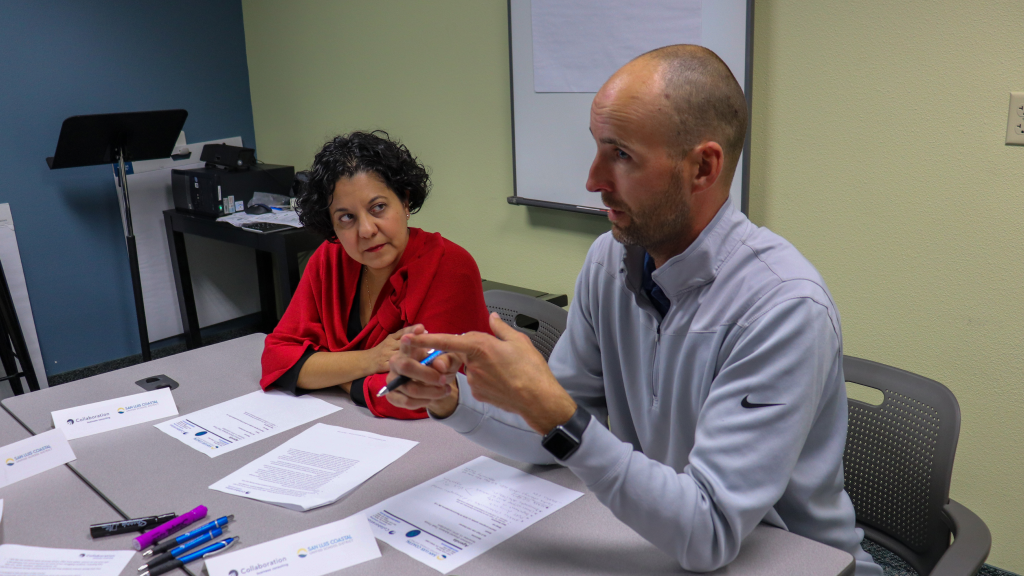
The Common Ground Task Force advises on equity issues. Photo courtesy of San Luis Coastal Unified School District.
Common Ground Advisory Task Force (CGATF)
A controversy erupted over an article and photo in the San Luis Obispo High School student magazine. The feature article on the LGBTQ+ community on campus sparked many responses, including a letter from a teacher that some considered hate speech. From this controversy, the San Luis Coastal Unified School superintendent created the Common Ground Advisory Task Force (CGATF). While the CGATF grew out of the desire for school environments that were inclusive for LGBTQ+ students, it has evolved to focus on inclusivity for any student or group who may experience discrimination or alienation in the district. This group is charged with helping the superintendent find common ground suggestions, through civil discourse, on challenging issues; providing policy and administrative feedback regarding religion, sexual orientation, free speech, harassment, and related policies; and providing recommendations that will improve conditions on school campuses for all students.
The CGATF is composed of 20 community, district staff, and secondary student leaders with a cross-section of civic and religious interests, including all major religions prominent in the community, free thinker/non-religious leaders, educational leaders, parents, and students. The CGATF serves in an advisory role, making recommendations to the superintendent that are submitted to the school board each spring before the development of annual board priorities.
Removing barriers: The CGATF listened to panel discussions from diverse groups of students, district teachers, and site administrators regarding steps to improve equity and inclusivity in the school district. The members recognized the district’s commitment to moving from equality (non-discrimination/equal access) to equity (promotion of equality) and inclusivity (creating a culture of care by engaging in proactive actions that acknowledge the dignity of all and the value of diversity).
The CGATF recognizes that families and the San Luis Coastal community share responsibility with district officials and staff to create a positive, equitable, and inclusive environment at all schools. Administrators are now looking at their programs through an equity lens. For example, the food service director describes her program as “being a lot more thoughtful in how we communicate about the free and reduced-priced meal program and how we identify students who may be overlooked and have a need.” They systematically analyzed historical data and gaps in enrollment to find sites where more students could benefit from the program. This focus has been successful at locating students who otherwise would have gone hungry.
Evidence of success: As a result of the CGATF’s recommendations over the past two years, San Luis Coastal has taken specific, actionable steps towards creating more equitable and inclusive schools across the district. Teacher recruitment practices have been modified to specifically search outside of the local area for staff who reflect the culture and heritage of district students. The CGATF has influenced annual board priorities by creating a focus on equity and a culture of care. This has influenced professional development, instructional strategies in the classrooms, and the types of diverse literature offered in the libraries and classrooms across the district. The multiyear district equity plan is evidence of how the CGATF played a vital role in how San Luis Coastal has turned controversy into positive, systemic change.
Contact
Eric Prater
Superintendent
eprater@slcusd.org
www.slcusd.org
Health Care Training for High Schoolers
Vail Unified School District, Vail, Arizona
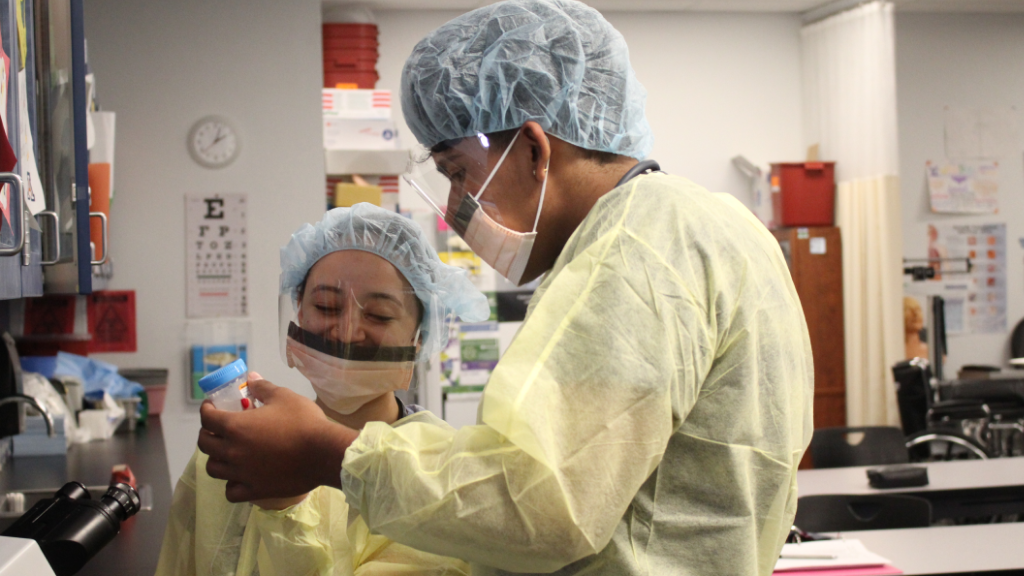
Healthcare Pathway students earn sought-after certifications. Photo courtesy of Vail Unified School District.
Andrada Polytechnic High School Healthcare Pathway
Andrada Polytechnic High School broke the mold of the traditional American high school. It has no athletics program. Instead, students choose from one of eight STEM-related majors or pathways. Andrada students identify with their major rather than a sport. Students take three required science courses along with another three pathway science courses. The experience culminates with a 120-hour internship during students’ senior year with high-quality professionals in a field. Andrada was designed and built for career and technical education programs, where the focus is a hands-on curriculum in a college-like campus community of 1,000 students.
Students in Healthcare Pathway classes, including medical assisting, sports medicine, veterinary assisting, and behavioral health, must be prepared for professional life. As such, students are treated as employees. They earn payment in the form of points and are allotted sick days, just as they might experience as personal trainers, physical therapists, veterinary assistants, or medical assistants. Students must request time off, can be docked “pay,” and must adhere to workplace standards.
Removing barriers: Andrada’s Healthcare Pathway is open to every student in Vail with varying levels of academic commitment and has no barriers to entry. The Healthcare Pathway students experience the same or greater success as their counterparts at career centers while leveraging all their other courses. Andrada offers specific pathways where students not only earn certifications in their fields but also where they are prepared to pursue advanced degrees within those fields.
Students who attend Andrada receive busing to the school. No additional transportation is required. Any student, regardless of disability, is welcome and encouraged to attend Andrada. Further, students are offered the Healthcare Pathway and training during the regular school day. The typical roadblock for students with transportation difficulties is eliminated. It is not a Saturday or evening program.
Often, students are required to pay extensive fees in similar health care programs to earn certifications. When Andrada faculty discovered that some students were opting out of taking national certification exams due to the expense, the school and district found a way to cover the expense through grants and other funding. Andrada provides transportation to the testing centers.
Evidence of success: Andrada’s Healthcare Pathway enjoys a 100 percent student completion rate. Every student in the medical assisting and sports medicine programs has earned passing scores on end-of-year assessments each year since Andrada opened in 2012. Medical assisting students consistently have the highest scores in the state, including in the top 20 last year. Students also take the national exams that adults take for certification. Adults who have gone through training courses take the test an average of three times before passing. However, 95 percent of Andrada’s medical assisting students have passed it on their first attempt, and 85 percent of sports medicine students did so. A passing score on the national certifications increases employability and college entrance opportunities. Andrada’s students are sought after by veterinary clinics, local university sports medicine programs, and various clinics around the state.
Contact
Rena Wittwer
Communications specialist
wittwerr@vailschooldistrict.org
https://vailschooldistrict.org
Over 20,000 enrollment
Closing Gaps Through Reading Instruction
Compton Unified School District, Compton, California
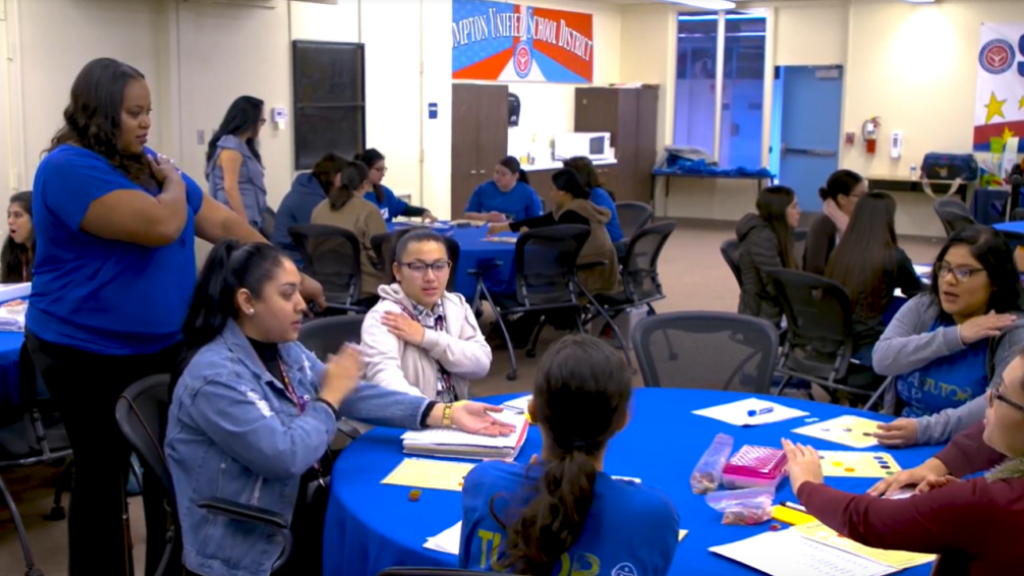
To ensure tutors’ knowledge and skills in literacy instruction, the district through the Ed Services Department provides thorough and systematic professional development. Photo courtesy of Compton Unified School District.
Project REACH
The district developed a partnership with California State University Dominguez Hills to address the need to build strong foundational reading skills in grades K-2 to close the achievement gap. They developed a partnership called Project REACH. Since then, the university has recruited hundreds of college students, many of whom are Compton graduates, to participate in the program. The district provides them with the necessary professional development and assigns them to the school sites as tutors. This program has increased reading proficiency, improved student behavior, and enhanced interest in learning. Furthermore, the rigorous training that the college tutors receive has better prepared them not only for the effective delivery of reading lessons but also for a future career in education.
Project REACH was prompted by the reality that less than 30 percent of the district’s student population in 2015 was reading on grade level by third grade. Based on baseline assessments, about 80 percent of students started kindergarten significantly lower in reading than their peers in more affluent districts. This deficit left students unprepared and without the essential early literacy skills that they needed to be academically successful. Students were leaving elementary schools reading well below grade level.
Removing barriers: The goal of Project REACH is to increase the reading fluency of at-risk students in grades K-2 through additional targeted tutoring provided by district-trained college tutors. By developing fluent readers, the program also aims to improve students’ interest in learning and their self-confidence. Students in Project REACH increase reading proficiency, and teachers and tutors have reported that these students also gain motivation and interest in school. In addition, there has been significant improvement in their attendance over time.
Evidence of success: The impact of Project REACH on the reading achievement level of the students receiving services is measured by multiple data points. The 2017-18 Achievement Improvement Monitoring System (AIMSweb), for example, provides student growth over time. In the fall, kindergarten students participating in the program recognized an average of 2.9 letters on the Letter Naming Fluency assessment. In the spring, the average increased to 37.6 letters, reflecting a growth of 34.7 letters. Second-grade students read an average of 15.3 words per minute (wpm) on the Reading Curriculum-Based Management (RCBM) assessment in the fall; the average increased to 52.8 in spring, reflecting a growth of 37.5 words.
The 2018-19 AIMSweb indicates student growth over time on alphabetic principle, phonics, and reading fluency. In the fall, participating kindergarten students recognized an average of 5.22 letters on the Letter Naming Fluency assessment. In the spring, the average increased to 31.94 letters, reflecting a growth of 26.72 letters. Second-grade students read an average of 22.8 wpm on RCBM assessment in the fall. The average increased to 54.64 in spring, reflecting a growth of 31.84 words.
Contact
Mario Marcos
Executive director, elementary schools
mmarcos@compton.k12.ca.us
www.compton.k12.ca.us
Help for First-Generation College-Goers
Guilford County Schools, Greensboro, North Carolina
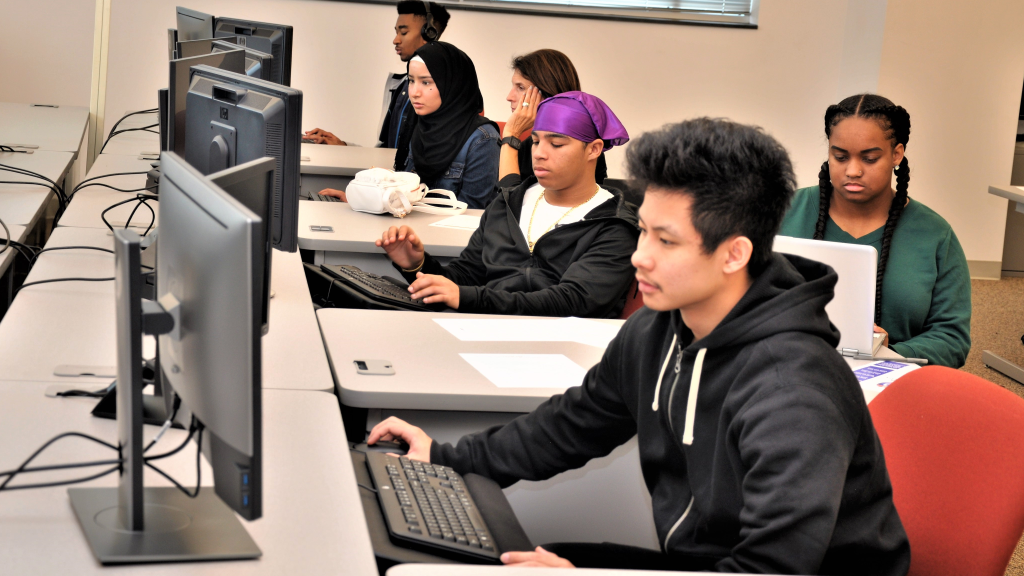
Cohort students who are in the refugee program are completing assignments. Photo courtesy of Guilford County Schools.
First Generation College Student Ambassador (FGCSA) Cohort Initiative
The Guilford County Schools First Generation College Student Ambassador (FGCSA) Cohort, administered through the Office of Diversity, Equity, and Inclusion, is now in its fifth year. It was created to provide opportunities for underserved youth to be the first in their families to attend college. The initiative started with 18 students in 2014-15 and has progressively grown to serve around 100 high school juniors and seniors each year.
The program components include the following: boot camp to prepare incoming students for the rigor of the initiative; monthly college cohort Saturday classes; college tours; and SAT and ACT prep classes.
Removing barriers: The FGCSA College Cohort classes, college tours, and, most certainly, scholarships remove barriers and expand access for achieving college entrance for underserved students. FGCSA assists students in setting goals, developing their gifts, identifying their strengths, and maximizing opportunities as they prepare for submitting college applications. Elements of the program include:
- Researching colleges for the “best fit,” which assists students in identifying institutions with higher graduation rates and more favorable institutional financial aid policies.
- Developing students’ college portfolios to expand their postsecondary opportunities.
- Supplementing the support offered by secondary school counselors who are frequently responsible for too many students to provide adequate college planning guidance and support to meet the needs of students.
- Assisting participants in seeking financial support so that they can complete their college programs once they are enrolled.
- Financing and financial planning remove one of the most significant barriers to college entrance for first-generation college students.
FGCSA Summer Boot Camp is a three-day training session specifically geared toward rising juniors who intend to transition into the FGCSA college cohort program in the fall. The session provides insight into what the program is and how it can benefit students who are serious about preparing for college and those who will successfully complete the program; basic training for new recruits entering the program to prepare students for what’s expected of them while in the program and when they enter college; and focused college planning activities that involve developing academic resumes; identifying best college matches; developing junior-year action plans; identifying gifts, talents, and branding; and identifying financial aid and scholarship opportunities.
Evidence of success: In total, the initiative has assisted nearly 400 students, most of whom are first generation and college aspiring, in developing comprehensive college-bound plans to expand college access and successfully navigate college admissions, scholarships, and financial aid. Participating students have been offered admission to top colleges. Scholarships received by cohort students have totaled in excess of $10 million over five years.
Contact
Esther Coleman
Executive Director, diversity, equity, and inclusion
colemae2@gcsnc.com
www.gcsnc.com
Bringing Books and Learning to Children
Hurst-Euless-Bedford ISD, Bedford, Texas

Students choose a free book to bring home. Photo courtesy of Hurst-Euless-Bedford ISD.
HEB Reads!
HEB Reads! is a partnership between the Hurst-Euless-Bedford ISD and the city libraries of Hurst, Euless, and Bedford, Texas. It was developed to lessen the effects of the summer reading slide, by creating a program that incorporated all the school and city libraries’ summer reading activities into one communitywide challenge. This partnership has expanded to include a mobile learning lab, the Think Tank, and a summer lunch and learn program— all designed and specifically located to reach students in low-income areas.
To kick off the annual summer reading campaign, the partnership hosts a communitywide reading event on the first Saturday in May. This free event has literacy and STEM activities, games, entertainment, information about summer offerings at all three city libraries and the schools, food, and more. Every attendee receives a free new book of their choosing to take home. Each year, the event has grown in popularity, starting with approximately 3,000 attendees in 2016 to over 4,500 in 2019. To date, the program has given away over 20,000 free books at the kickoff events.
The Think Tank is a mobile STEM lab and features everything from snap circuits to paper circuits to robots to computers to straw connectors. It offers free hands-on learning for all ages and has both plugged and unplugged activities. The Think Tank appeared at 52 school and city events in the 2018-19 school year. This outreach mobile lab sets up in apartment complexes, at city block parties, and at school carnivals. The program includes a summer lunch-and-learn site within the middle of a nine-apartment-building community complex. Children can come every weekday to receive a free hot meal and have access to no-cost educational opportunities in a safe, air-conditioned environment.
Removing barriers: HEB Reads! seeks to take resources to the learner, both physically and academically. The program addresses barriers of food insecurity and lack of constructive activity that reinforces learning. It also builds trust between students and authority figures, establishing a climate of respect in an atmosphere more relaxed than the regular school environment.
Evidence of success: HEB Reads! was officially launched in May 2016 and continues to post positive trends in the number of attendees at the kickoff event and in minutes read during the summer. In year one, the district only collected data from the school district (1.93 million minutes of reading). In year two, it added additional data points for adults, home schools, other districts, and children under 4 years old. It disaggregated the data for each city library as well so that it would have numbers to present to the city councils. And the numbers speak for themselves: from 1.93 million minutes in 2016 to almost 7.5 million minutes in 2019.
The Think Tank made its debut last year. It made an appearance at 52 different school and city events and delighted thousands of children and adults. The eight-week summer lunch-and-learn has grown extensively in just one year, with the number of lunches served increasing by over 135 percent and the number of learners participating up by over 125 percent.
Contact
Deanne Hullender
Chief public relations and marketing officer
deannehullender@hebisd.edu
www.hebisd.edu
Access and Opportunity
Montgomery County Public Schools, Rockville, Maryland
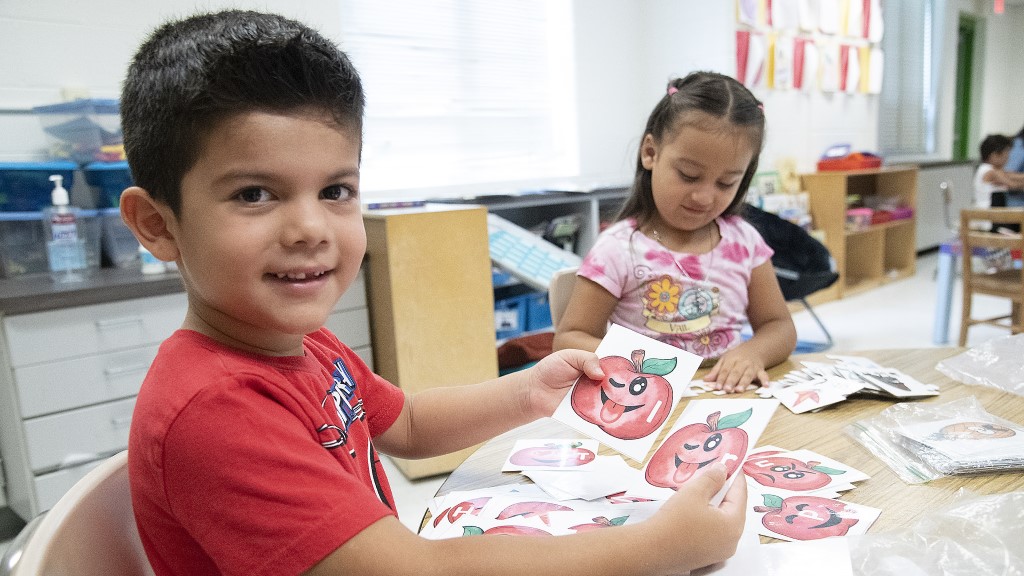
Students benefit from a plan and analysis of disaggregated data. Photo courtesy of Montgomery County Public Schools.
All In: Equity and Achievement Framework + All Means All Initiatives
The All In: Equity and Achievement Framework, in conjunction with the All Means All initiatives, provide the purpose, plan, and path to ensure success for all students. It has three interconnected components:
The Evidence of Learning (EOL) framework consists of multiple measures in classroom, district, and external categories that allow schools and the district to monitor individual student progress at each level—primary, intermediate, middle, and high school with the goal of being college and career-ready.
The Equity Accountability Model (EAM) uses EOL data to determine the impact schools have on students who have typically not performed as well as their white and Asian peers.
The Equitable Access to Resources tool (EAR) examines how well the system and schools are using staff, time, and money as measured by student outcomes, with emphasis on the five focus groups. The EAR focuses on an analysis of student performance and funding data to provide a diagnostic view that analyzes the student experience through the lens of equity, such as leadership quality, teaching quality, instructional time and attention, rigorous and empowering curriculum, diverse and inclusive classrooms, and the whole child.
Together, these integrated components provide the data needed for schools to take targeted action to close the achievement gap and ensure that success cannot be predicted by race or socioeconomic status.
The All Means All initiatives ensure that all students, regardless of their backgrounds, have the access and opportunities needed to meet their full potential and to be successful in college, career, and community. These initiatives include dual/two-way language immersion, universal screening and expanded access to enrichment.
Removing barriers: For 50 years, the achievement gap in Montgomery County has grown in the shadows while many of the county’s schools and students garnered well-deserved praise and earned awards. Despite efforts by county leaders, the gap continued to grow, overshadowed by aggregated data, which allowed the struggles of some students to be masked behind the outcomes of their peers in one of the nation’s largest school districts. This disparity in academic outcomes is a crisis in the community that must be addressed. Through the initiative, the district has granular, disaggregated data that allows educators to take targeted, individualized actions to combat the specific barriers to equity and excellence.
For instance, through EOL, a school can review the real-time data of a specific student, identify an area of struggle, and provide in-the-moment additional or differentiated instruction. Through the EAM, a school and the community can know that Latinx students not impacted by poverty are underperforming relative to their peers and the standard, and then develop a school improvement plan that increases the focus on supporting that particular group. And, through EAR data, a school will know if its assignment practices are disproportionately placing students of color with less experienced educators.
Evidence of success: The components of both the All In Framework and the All Means All initiatives began rolling out in the 2016-17 school year. Since this time, the district has seen significant progress toward closing the gap in student outcomes.
Contact
Derek Turner
Chief communications officer
derek_g_turner@mcpsmd.org
www.montgomeryschoolsmd.org
Fresh Start for the New School Year
Virginia Beach City Public Schools, Virginia Beach, Virginia
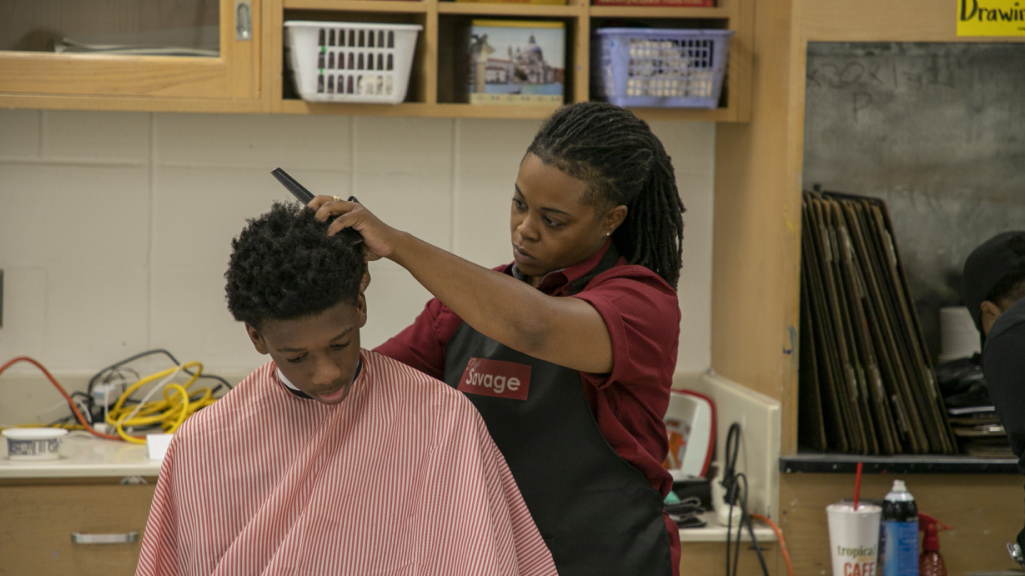
Students receive back-to-school necessities and services. Photo courtesy of Virginia Beach City Public Schools.
JumpStart
Created as a partnership between the Virginia Beach-based nonprofit AidNow and school social work services with Virginia Beach City Public Schools, JumpStart is an annual event for students identified as homeless and marginalized to receive everything needed to start school. This includes backpacks, school supplies, clothing, haircuts, and more. School social work services houses Project HOPE Virginia Beach, the McKinney-Vento Homeless Education project for the district.
The partnership began in September 2009 when a member of the AidNow board reached out to the district coordinator of social work services. The main issue identified was clothing. Clothing was needed in a large quantity, in various sizes, and for different seasons.
To remedy this issue, AidNow arranged for a storage facility, and within eight weeks, the facility was filled with new or nearly new clothing. However, throughout the 2009-10 school year, the requests for assistance with clothing continued, and AidNow began to question what these students were doing for clothing at the start of each school year.
That was the impetus for JumpStart 2010: provide identified students with new or nearly new clothing so all students can begin school with new outfits and other necessities. JumpStart has grown into a partnership that brings together nonprofits, service organizations, city agencies, schools, and several corporate sponsors to provide students with everything they need to start the school year. Students choose clothing, socks, underwear, new hoodies, new shoes, and more.
Besides clothing and haircuts, vision and dental screening are offered, as well as information on health care and other available services. Families also may obtain public library cards and books. Corporate sponsors provide bags of healthy food and hygiene products. Students pick out a new backpack and school supplies.
Removing barriers: A student who starts the school year with ill-fitting clothing, uncut hair, dirty shoes, and a backpack with a broken zipper may not feel the confidence needed to be a successful student. Students who don’t have the support they need to feel equal to their peers can suffer from a lack of confidence and self-esteem, which can lead to absenteeism and poor academic achievement. An unstable home environment, which may include homelessness, separation from parents/family, or not knowing where they will sleep at night, can create barriers that may seem insurmountable. With JumpStart, students can look forward to the fresh start of a new school year. Building student confidence and giving them a positive outlook on the upcoming school year can have lasting effects.
Evidence of success: JumpStart has been an annual event for nine years, held the third Thursday in August, before the start of school. Students attending the first two years received two outfits, a haircut, and school supplies. The program now averages 500 student attendees each year. Over 200 community members volunteer their time to planning, setting up, and providing day-of support for the event. The school social workers also attend the event to distribute school supplies and assist in other areas as needed.
Contact
Natalie Allen
Chief communications and community engagement officer
natalie.allen@vbschools.com
www.vbschools.com

Share this content